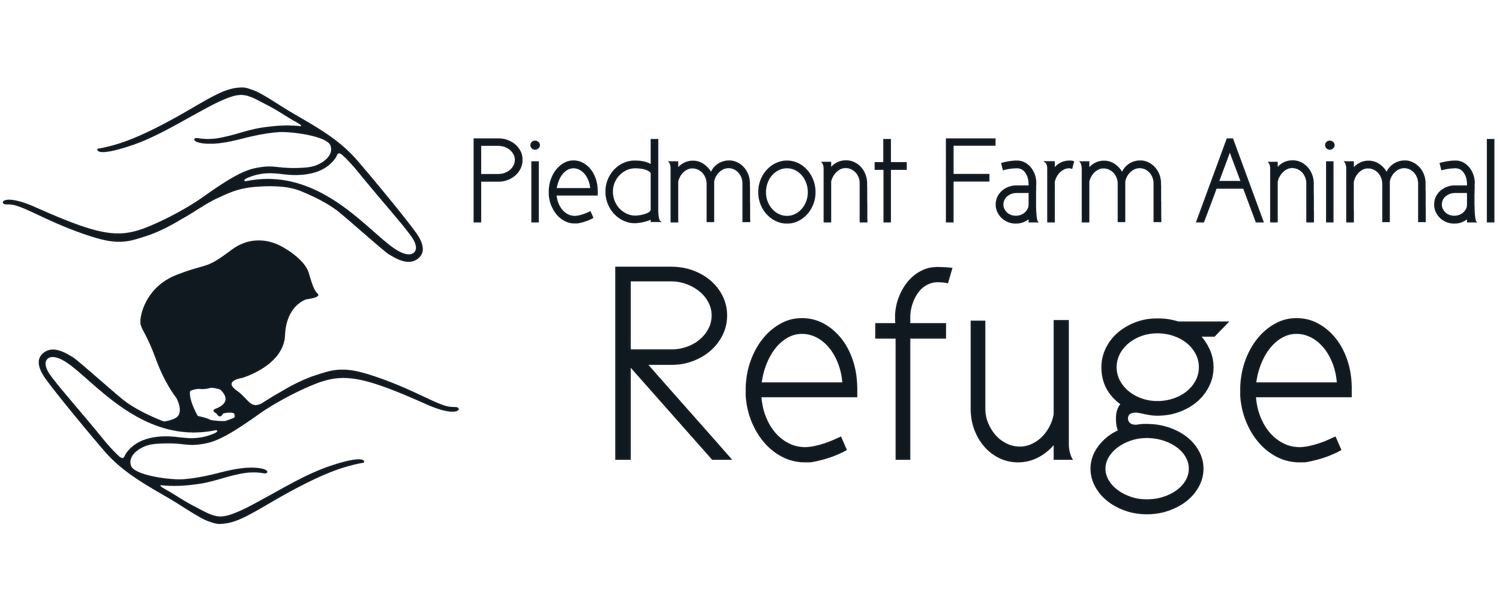Factory Farming: Sheep
By Barbara Hengstenberg for Piedmont Farm Animal Refuge
Did you know that sheep and humans have much in common? Surely, not by outward appearances, but go a little deeper into the research and you will discover that sheep and humans process visual information much the same way. Sheep exhibit increased heart rate, stress hormones, fear, and bleating (screaming) when separated from their flock. Food digestion becomes more difficult, they drink less water and become restless when under duress. Like most humans, they have a strong social unit and can even recognize other sheep faces from photographs. Sheep often rub heads and make cheek-to-cheek contact with their flockmates. Their strong bonding within their flock leads them to become more adventurous when they are with their family.
At the Refuge, we have found that it holds true that sheep form attachments with certain people and are able to recognize them even after a long separation. They respond to emotional cues from people and their fellow sheep, and they prefer smiling human expressions. Sound familiar?
However, the human-sheep similarities are grossly ignored on factory farms, where sheep face severe inhumane treatment. Over 2 million sheep are killed every year for meat. Since lamb is a preferred meat, most are slaughtered at less than one year old. These young lambs have already led a painful, short life. Soon after they are born, their tails are docked (cut off) in order to prevent the build-up of fecal matter. Cutting off their tails or rotting them off by choking the tail with a rubber ring fastener leads to chronic pain and an increased occurrence of rectal prolapse.
Four sheep residents at the Refuge (Luther, Clover, Molly and Oliver), were born after their mothers (Coretta, Coconut, and Esme) were rescued from a backyard butchery where the moms were raised to produce lambs. Luckily, these four lambs were born at the Refuge, where they live in a world of love and safety.
Sheep raised for their wool face a similar fate as those raised for meat. Again, wool from younger sheep is preferred, and once their production decreases, they are sent to slaughter. Most of the world’s wool comes from Australian sheep. After years of producing wool for market, these sheep are then shipped live to the Middle East to be slaughtered for meat. Their ocean journey is a crowded, tortuous trek which can take over three weeks, only to have their throats slashed upon arrival…while fully conscious.
Most of the sheep raised in Australia are merino sheep. Merino sheep have wrinkly skin, which makes them vulnerable to fly larva infestation. Horrifically, the treatment, called mulesing, involves removing large amounts of skin from the sheep’s backside while they are fully conscious with no pain medication or anesthesia.
Lanolin, the waxy substance secreted by wool-bearing animals, is usually extracted from the sheared sheep’s wool. This substance is used in many cosmetics and lotions used for moisturizers, as well as in many industrial products. Most shearers are paid “per sheep,” so they rush through the shearing procedure, leading to cuts and nicks, which then lead to infections that are rarely treated. After years of this painful treatment during shearing, they are sent to slaughter.
Since wool-bearing sheep have been bred to continuously grow their wool, the sheep residents at the Refuge require yearly shearing. Too much wool leads to heat-related ailments and other health issues. Understanding this, we work with a gentle shearer who takes the time to shear each sheep in as peaceful a way as possible. Because of this, our flock is sheared over many days, but are much happier for it.
Before arriving at Piedmont Farm Animal Refuge, our sheep residents faced lives of abuse, untreated illnesses and wounds. But here at the Refuge, they live in housing that was designed for their specific needs. They are greeted each day by friendly, smiling faces, and given free reign of their pastures, fresh hay, food, water, and treats. Volunteers provide hours of kindness, laughter, and enrichment activities to these gentle residents. With so many similarities between sheep and humans, it’s easy to connect with one another, and to smile when we interact.
What can you do to help the sheep who face horrific lives on factory farms? Come out to the Refuge and visit the sheep residents. They will quickly put a smile on your face, and you will better understand how similar they are to us. You will see their playful side, and their joy in their newfound lives as they stroll out to the pasture to graze with their flockmates.
Consider and promote alternatives to the cruel practices of factory farming. Learn more about reducing your consumption of and use of sheep products. Share what you’ve learned with others.
Resources:
Hatkoff, Amy. The Inner World of Farm Animals: Their Amazing Social, Emotional and Intellectual Capacities. NY: Henry N. Abrams, Inc., 2009, pp. 123-136.


